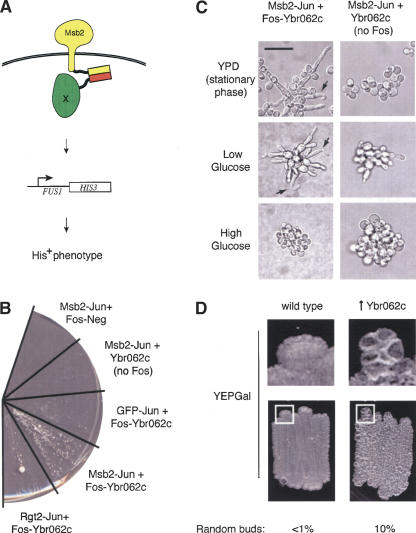Figure 3.
A screen for proteins involved in the filamentous growth MAP kinase pathway. (A) The screen was designed to identify proteins that activate the filamentous growth pathway by forcing proteins to interact with Msb2 through a leucine zipper–mediated interaction. Msb2 is a plasma membrane protein required for activation of the filamentous growth MAP kinase cascade (Cullen et al. 2004). A candidate is identified as a protein that when forced to interact with Msb2 stimulates basal expression of the pathway, possibly by causing MAP kinase components to assemble a complex at the plasma membrane. Activation of the pathway induces expression of an Msb2-dependent reporter (Cullen et al. 2004) that allows the yeast to grow on media lacking histidine, provided that the filamentous growth pathway is intact. Proteins that are not part of the signaling pathway do not activate the pathway and thus do not confer growth on medium lacking histidine. (B) Induction of the filamentous growth pathway occurs when Msb2 and Ybr062c are forced to associate as leucine zipper fusions. Yeast coexpressing the indicated proteins were streaked on medium lacking histidine and grown at 25° for 9 d. The large colony in the Rgt2-Jun + Fos-Ybr062c sector is a likely revertant. Fast-growing revertants were seen with some combinations of proteins. (C) Forced interaction between Ybr062c and Msb2 results in morphologies associated with filamentous growth pathway hyperactivation. Cells containing the Msb2-Jun and Ybr062c-Fos fusions (left panels) or Msb2-Jun and Ybr062c alone (right panels, no Fos) were grown to stationary phase on SD minus uracil, leucine, and tryptophan solid-agar medium (top panels; stationary phase), or examined in the single cell invasive growth assay (Cullen and Sprague Jr. 2000) in glucose-limited (middle panels; low Glucose) or glucose-rich (bottom panels; high Glucose) medium. In addition to the elongated cell morphologies observed in cells associated with the Msb2–Ybr062c interaction, bent-cell morphologies were observed (arrows) indicative of hyperpolarized growth. As with hyperactive alleles of Msb2 (Cullen et al. 2004), glucose suppressed morphologies arising from the Msb2–Ybr062c interaction. Bar, 20 μm. (D) Phenotypes associated with overexpression of Ybr062c. Cells with wild-type level of Ybr062c (wild type; strain 538) and cells containing pGAL1-YBR062c (↑Ybr062c; strain 1492) were patched onto YEPGal media. The plate was incubated for 72 h at 30°C and photographed. An enlarged region of the colony border defined by a white square is also shown. A higher percentage of cells overexpressing Ybr062c also had a random budding pattern than wild-type cells, which was scored by direct visualization of cells scraped from YEPGal plates incubated for 24 h at 30°C.

